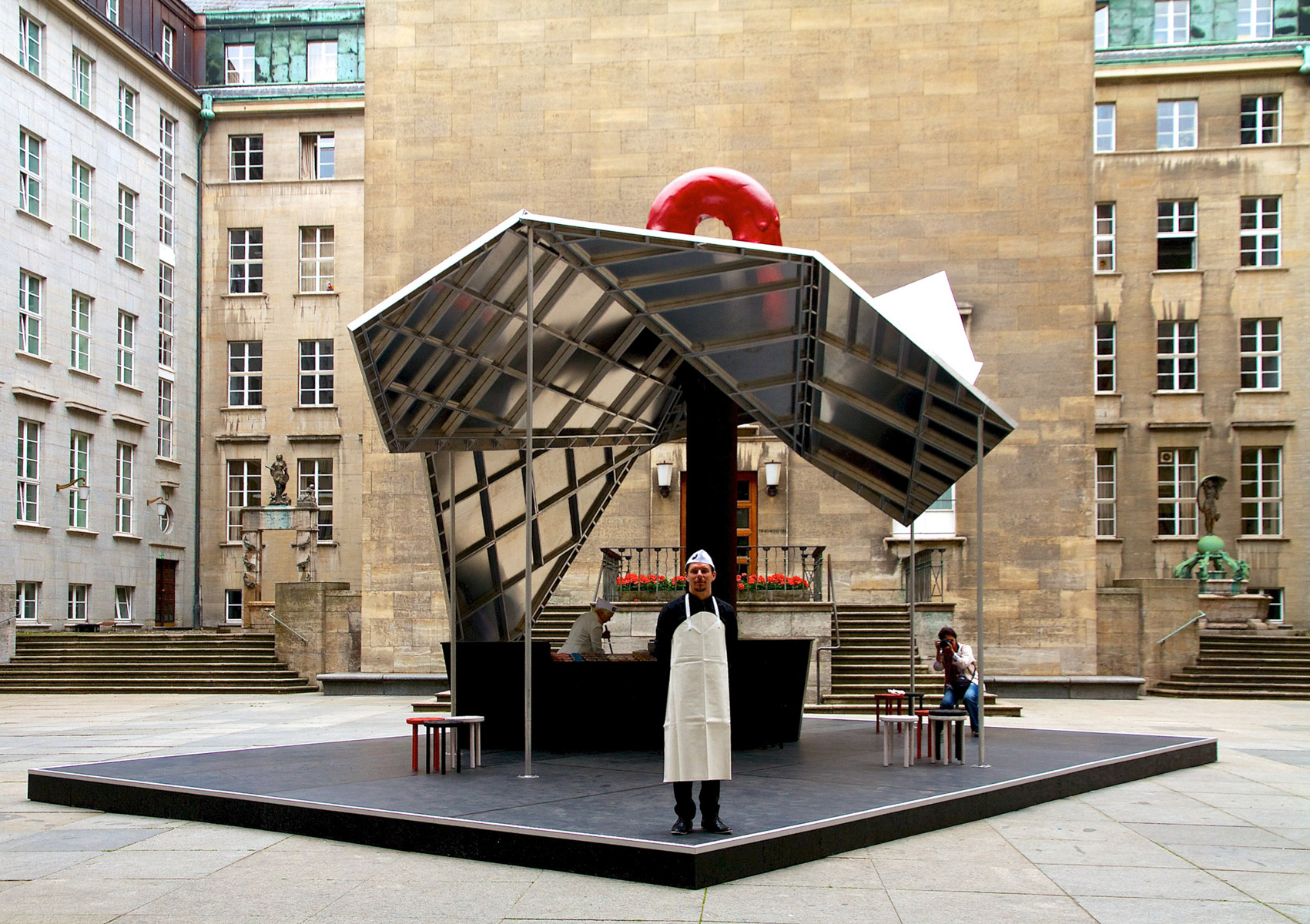2014, Bochum, Germany
All’s Well That Ends
Aluminium, timber, steel, and actors, 10 x 11 x 12 m
Performed by Edith K. ‘Tek’ Wilson and Alexander Ritter
Curated by Paul Domela and Katja Aßmann
Commissioned by Urbane Künste Ruhr and Schauspielhaus Bochum
for Das Detroit-Projekt







In many ways, the performative installation All’s Well That Ends summed up the Morisons’ approach to working, for in this single piece art, architecture, and theatre all blended as one. A central theme of their practice is the question of how individuals can overcome moments of personal misfortune and crisis, and this project was no exception.
It was produced for the Das Detroit-Projekt, an exhibition across Bochum, a major industrial centre in the Ruhr area of Germany. The exhibition took place in response to the closing of the local Opel car plant, owned by the US multinational General Motors. With the closure of the factory, the city of mining and industry not only suffered the loss of three thousand jobs and the indignity of its fate being decided by its American paymasters, it also faced the transition to a post-industrial future, the biggest paradigm shift in its history. For generations, the city had been dominated by major industries. But now the changes required new sources of work and employment, as well as alternative forms of education and culture. Bochum knew that it had to change profoundly. It also decided that it did not want its future to be determined by others, but wanted instead to take control of its own destiny. Das Detroit-Projekt was related to comparable projects in three other European Opel cities (Ellesmere Port in Britain, Gliwice in Poland, and Saragossa in Spain), which were also facing uncertain futures with the end of the Opel era.
It was produced for the Das Detroit-Projekt, an exhibition across Bochum, a major industrial centre in the Ruhr area of Germany. The exhibition took place in response to the closing of the local Opel car plant, owned by the US multinational General Motors. With the closure of the factory, the city of mining and industry not only suffered the loss of three thousand jobs and the indignity of its fate being decided by its American paymasters, it also faced the transition to a post-industrial future, the biggest paradigm shift in its history. For generations, the city had been dominated by major industries. But now the changes required new sources of work and employment, as well as alternative forms of education and culture. Bochum knew that it had to change profoundly. It also decided that it did not want its future to be determined by others, but wanted instead to take control of its own destiny. Das Detroit-Projekt was related to comparable projects in three other European Opel cities (Ellesmere Port in Britain, Gliwice in Poland, and Saragossa in Spain), which were also facing uncertain futures with the end of the Opel era.
Known for developing an architecture of personal transition, the Morisons created a sculpture that abolished the lines separating artistic disciplines. This ‘protective sculptural form’, installed at the centre of Bochum’s town hall, pointed to the opportunities of unexpected radical change – as well as being a functioning doughnut kiosk. The light structure had an irregular folding aluminium roof and steel supports. The installation was set up in the town hall’s inner courtyard for the summer. Each day, there was a four-hour performance by actors Tek Wilson and Alexander Ritter, which included the real sale of doughnuts alongside an improvised drama. Theatrical moments were generated, a slowly developing improvisation unfolded, a psychological drama played out, a slapstick comedy of doughnuts unravelled, and a piece of absurd theatre was left. Thus was shown the emotional struggle of conciliating inner truths and public perception. Personal change becomes necessary in a situation of enforced transformation.
‘It is an absurdist immersive sculptural theatrical alegory for the shame and frustration felt by the workers of Bochum’s General Motors factory, closed down and relocated by its American owners, despite its high productivity.’ Ivan Morison
‘It is an absurdist immersive sculptural theatrical alegory for the shame and frustration felt by the workers of Bochum’s General Motors factory, closed down and relocated by its American owners, despite its high productivity.’ Ivan Morison
Photographers’ credits
All’s Well that Ends_ Ivan Morison
All’s Well that Ends_ Ivan Morison